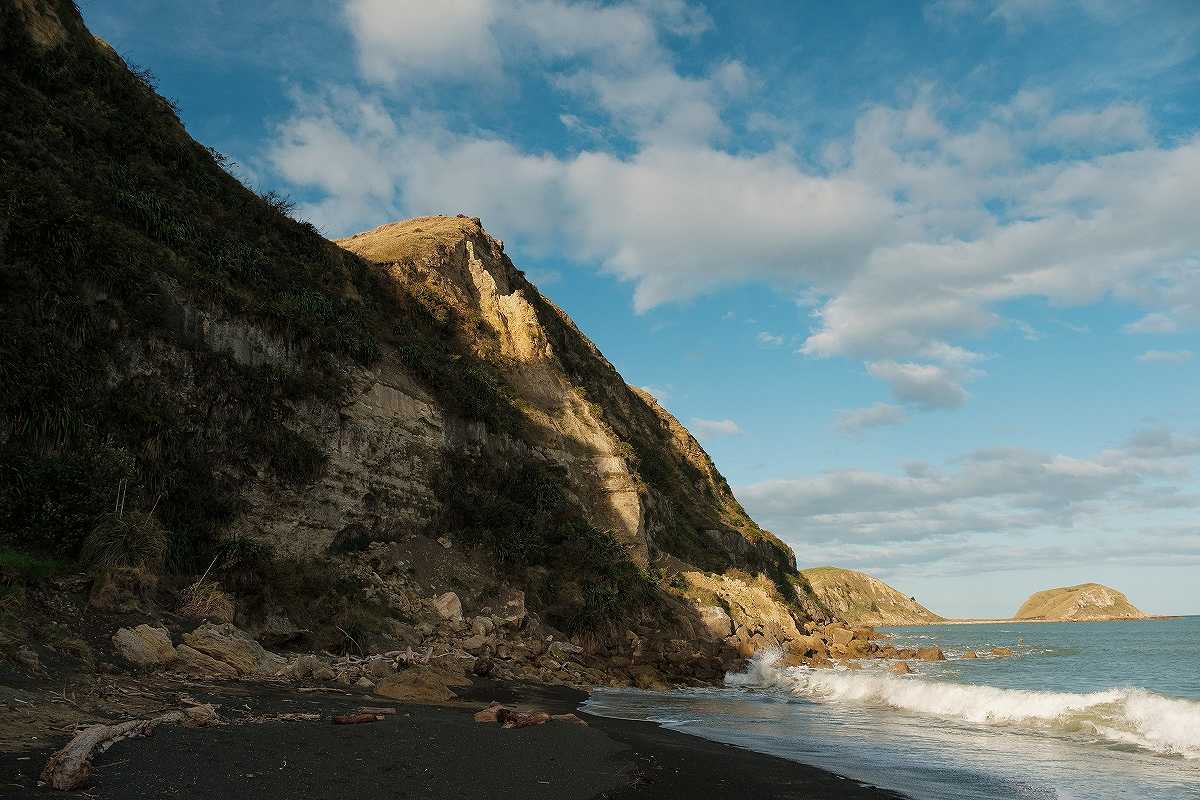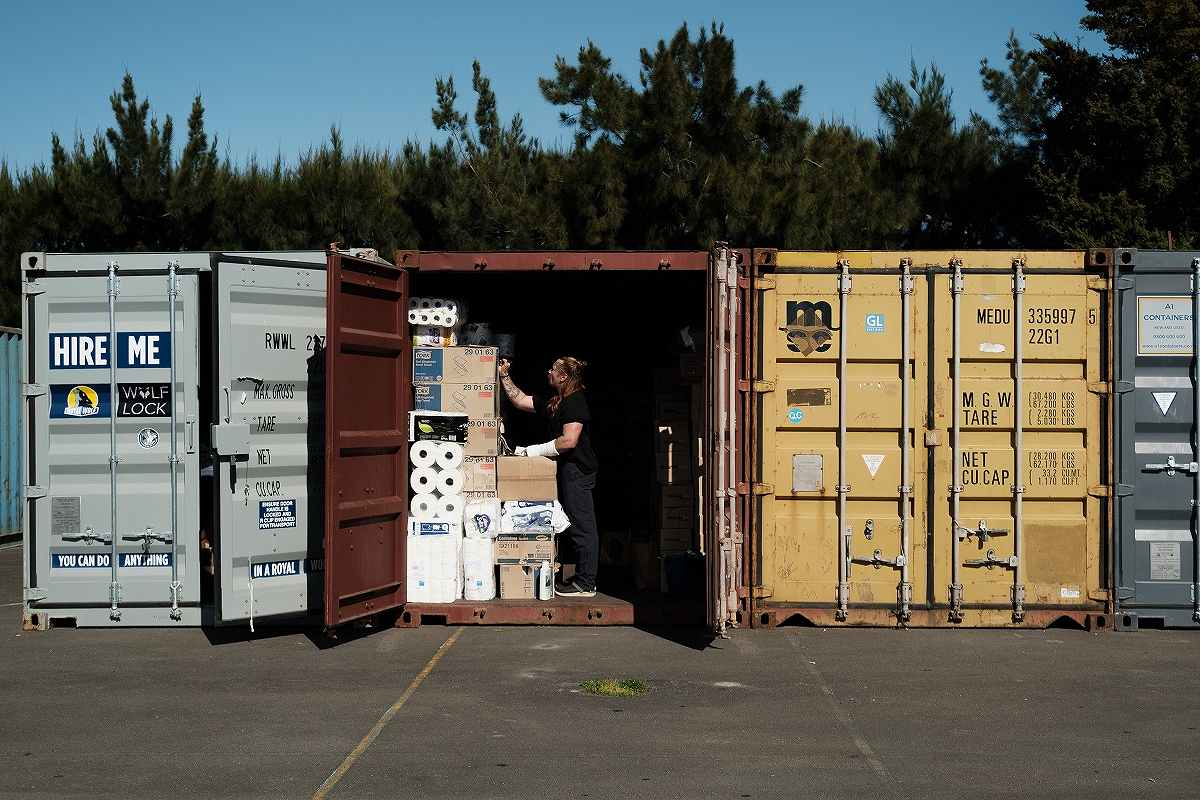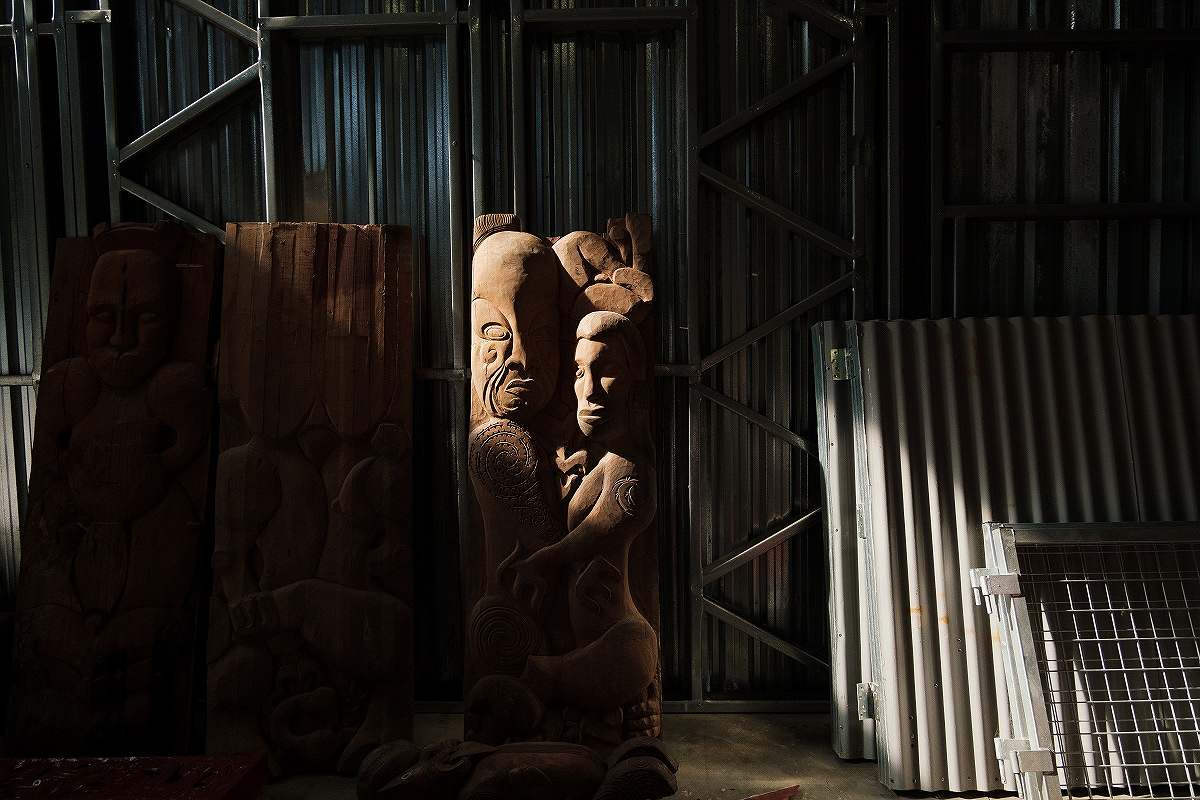
The eroding coastline at Tangoio beach. This 200-mile stretch of coastline has one of the highest rates of erosion and sea level rise in New Zealand.
16:01 JST, October 28, 2023
TANGOIO, New Zealand – The wharenui, or meeting house, stood forlorn. Usually the hub of this remote Maori community, it had been stripped of its wooden carvings. The bare cinder block shell gave the building an unclothed appearance. Wind whistled through holes bashed out by floodwaters.
An official red notice prohibited entry to the adjacent dining hall, where the walls were askew, jammed with twigs and debris. The preschool was shuttered, the children gone. Down the valley, dump trucks whirred as they hauled silt from ruined fields.
Eight months have passed since a powerful cyclone struck northern New Zealand, killing 11 people and displacing more than 10,000. The storm’s path across the Hawke’s Bay region was indiscriminate: it pummeled low-rent housing alongside million-dollar homes, wineries, orchards and factories. But the barriers to recovery here highlight the double whammy dealt to Indigenous communities by climate change, as extreme weather events exacerbate already high rates of homelessness and economic disadvantage.
In parts of Hawke’s Bay, February’s cyclone is in the rearview. Streets have been tidied up. Insurance claims lodged. Levees repaired. Meanwhile, communities like Tangoio face painful choices about their future after authorities declared their land too risky to reinhabit.
Tangoio and dozens of Maori communities are on the front lines of climate change, a dark legacy of British colonization which saw Indigenous people consigned to inhospitable land. Many are on flood plains or near the sea. Historically, tribes moved between coastal villages and fortified hilltop settlements when they faced bad weather or enemy attacks. Colonial land confiscations changed that.
“Some of these marae don’t have any other land if you take them off that flood plain,” said Bayden Barber, chairman of Ngati Kahungunu, the main Maori tribe in the region. (The marae is a sacred Maori meeting ground for tribal gatherings, encompassing a wharenui, dining hall and urupa, or burial grounds.)
“They used to own that whole region. That in itself is a travesty. And now climate change is pushing our people off the last little bit of whenua [land] that they actually own,” Barber said.
The government has agreed to split with local authorities the cost of buying out homeowners affected the most to get them to relocate. But the plan doesn’t account for Maori communities’ deep spiritual connection to ancestral land, or for shared land ownership. Nor does it consider previous legal settlements the government has signed with Indigenous groups guaranteeing access to tribal land and resources, including seafood. The government has been compensating tribes across the country since the late 1980s as redress for colonial wrongs.
In 2013, officials came to Tangoio to apologize for a brutal history of military attacks and land confiscations that had left them “virtually landless,” according to the government minister in charge at the time.
Although the buyout plan is voluntary, categorizing land as uninhabitable has made it problematic to insure against future disasters.
“We don’t want to build a marae, which is priceless, on a piece of land where the insurers won’t touch us,” said Hori Reti, chairman of Tangoio Marae, which counts 6,373 people in its community.
Relocated by force during colonial times, climate change is forcing another kind of relocation on Tangoio. Experts call it “managed retreat.”
– – –
‘They call me Moses’
When the storm struck Tangoio in February, Reti was trapped as a wall of water approached like a freight train. He huddled with his wife in the pitch dark. Somehow, trees uprooted by the storm piled up like a dam behind their home, parting the floodwaters around them.
“They call me Moses,” Reti said wryly.
For Reti, 44, the cyclone is a reminder of historic loss: firstly through colonial land confiscations, and later the Public Works Act, which allowed land to be claimed for roads.
He pointed toward a vacant plot where his great-grandmother’s house once stood. Authorities plowed a road right through her front garden, Reti said with exasperation. Similarly, a coastal highway that curves into the valley, away from the Pacific, cut so deeply into the hillside that a historic home atop it had to be demolished.
When municipal valuers visited after the cyclone, Reti said he couldn’t fathom their language. They spoke of assets: a bridge and the state highway. For Reti, value is in the spot in the river where his ancestors gave birth and the sacred ground where they’re buried.
“How will we get that mirror effect on another piece of land?” he said.
Reti is set on restoring the Tangoio Marae for its people to return to. But they’ve weathered six big floods since they were hemmed onto this plain. With their landholdings reduced from around 275,000 acres to a mere four acres, Reti asks, where can they go?
– – –
Climate warriors
Tangoio’s struggles highlight the difficult issues around managed retreat: Who decides when to retreat and on what basis, and how do you pay for it?
It foreshadows the troubles that could befall other low-lying communities as storms intensify and seas rise. In the United States, the Biden administration last year gave a number of Native American tribes money to help them relocate away from rivers and coastlines.
This 200-mile stretch of coastline has one of the highest rates of erosion and sea level rise in New Zealand. Tens of thousands of people are expected to have to move out of harm’s way around the country in coming decades. So far, New Zealand’s only case of managed retreat – after a massive landslide – took nearly two decades to resolve.
“Are we going to be courageous enough, as the elected leaders, to say we’ll do something different, or will we just be another footnote in history?” said Nigel Bickle, the chief executive of Hawke’s Bay District Council. “What is going to mark out the countries globally are those that are going to be prepared to deal with this.”
Bickle, who has clashed with tribal officials over relocation proposals, understands the quandary. “We’ve come in and said there’s an intolerable risk to life and you shouldn’t be living there,” he said. “And they’re saying: ‘Who is going to help us find a piece of land that is safe?'”
For years, the Tangoio community has been exploring ways to protect the settlement from climate change – including relocating to higher ground. They approached several landowners about repurchasing land within their traditional borders. All three declined.
Before the cyclone, the community was preparing to redevelop the meeting house on a raised platform. Those plans are now in doubt. Even before local authorities ruled the area unsafe, some were questioning the merits of rebuilding in a flood zone. They’re seeking regulatory support to purchase “resilient land.”
The previous center-left Labour administration was looking to include Indigenous knowledge in its climate change planning to avoid a repeat of past wrongs. But Tom Fitzgerald, a climate expert, said officials are “building the plane as they are flying it,” combining their disaster response with climate plans still under development. A national election in October that moved New Zealand sharply to the right adds to the uncertainty.
– – –
Hilltop fortresses

The Maori community at Waipatu became an evacuation center for people displaced by the cyclone. Tane Tomoana works inside a storage container filled with donations for families in need.
For many Maori communities, relocation is not an unfamiliar concept.
There is evidence of managed retreat occurring as far back as the 1800s, when a volcanic eruption forced Maori communities to relocate, said Akuhata Bailey-Winiata, an Indigenous scholar at Waikato University. Other tribes offered land to those whose settlements were buried in tons of ash and debris.
About 35 miles south of Tangoio, the Omahu Marae community is planning a 10-year retreat to a historic hilltop fort after the cyclone inundated their meeting house and burial grounds, exposing human bones. North of Tangoio, plans are afoot to move the community – and possibly the entire town of Te Karaka – to higher ground.
For some Maori, the cyclone underscored their resilience. At Omahu, around 1,200 people came to help. Within days they were providing meals and shelter to families displaced by floodwaters.
At nearby Waipatu Marae, Tane Tomoana had just completed civil defense training when an army truck carrying 120 flood survivors turned up. That training was no longer academic. “We remembered who we were meant to be. It’s a really good reset. Maori, catering for everybody, with joy and gusto,” he said.
Eight months on, some flood survivors are still living at Waipatu, including 69-year-old Hiria Tumoana, whose home was inundated by head-high waters. She was rescued by a neighbor who saw her candle flickering and found her clinging to an upturned bed.
Returning to Maori village life felt like a homecoming, she said. At night, she sleeps in a communal space with other families. That companionship helps, she said, especially when it rains – a sound many survivors find triggering.
– – –
Uneven hand
For others, the recovery is not so easy because they have so little land left.
At Petane Marae, just south of Tangoio, the community had just renovated their dining hall and were about to build a new meeting house when the storm hit. Now, like Tangoio, they’ve been zoned uninhabitable.
“We are unable to build our wharenui for our people to come back to us,” community chairwoman Rose Hiha said one recent afternoon, wiping away tears.
Some members want to fortify the area with levees. Others are afraid to return. Twisted railway lines pay grim tribute to the storm’s ferocity. Wrecked cars are frozen in time where they washed up. A Maori school is half-buried in debris.
At a Napier warehouse one afternoon, Joe Taylor, a Tangoio elder, chiseled away at a limestone sculpture, beginning a restoration project he predicted will outlive him.
Under the 82-year-old’s guidance, the remaining artifacts were recently removed from Tangoio to preserve them for the day they return to sacred ground.

Carvings from the damaged meeting house at Tangoio were recently removed to restore them for the day they return to sacred ground.
"News Services" POPULAR ARTICLE
-

American Playwright Jeremy O. Harris Arrested in Japan on Alleged Drug Smuggling
-

Japan’s Nikkei Stock Average as JGB Yields, Yen Rise on Rate-Hike Bets
-

Japan’s Nikkei Stock Average Licks Wounds after Selloff Sparked by BOJ Hike Bets (UPDATE 1)
-

Japanese Bond Yields Zoom, Stocks Slide as Rate Hike Looms
-

Japan’s Nikkei Stock Average Buoyed by Stable Yen; SoftBank’s Slide Caps Gains (UPDATE 1)
JN ACCESS RANKING
-

Keidanren Chairman Yoshinobu Tsutsui Visits Kashiwazaki-Kariwa Nuclear Power Plant; Inspects New Emergency Safety System
-

Imports of Rare Earths from China Facing Delays, May Be Caused by Deterioration of Japan-China Relations
-

University of Tokyo Professor Discusses Japanese Economic Security in Interview Ahead of Forum
-

Japan Pulls out of Vietnam Nuclear Project, Complicating Hanoi’s Power Plans
-

Govt Aims to Expand NISA Program Lineup, Abolish Age Restriction



















